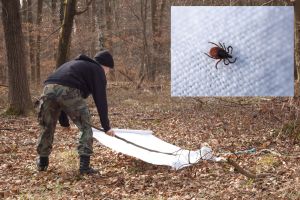Annually, more than 100,000 persons are infected by borreliosis through tick bites, about 300 come down with tick-borne encephalitis (TBE). A team of parasitologists and geoecologists studies in which areas ticks carry which pathogens, where their population is extremely high, and which environmental impacts are responsible. The results are supposed to help issue more detailed vaccination recommendations or tick warnings. The project is funded as a BWPLUS project by the Baden-Württemberg Ministry of the Environment, Climate Protection, and the Energy Sector.
The most abundant type of ticks in our latitudes is the castor bean tick (Ixodes ricinus) that passes the development phases of larva, nymph, and adult in the course of its life. To reach the next phase, the tick needs a host. This is exactly where the KIT researchers start. In various regions of Baden-Württemberg, they want to collect ticks from mice, the most frequent host animals of the larvae. The ticks will be examined for pathogens by the State Health Authority, the mice will be marked and set free again. Several weeks later, it is planned to catch mice in the same areas again. “Based on the number of marked and recaught mice, we can calculate how many potential host animals live in a certain area,” explains KIT parasitologist Dr. Trevor Petney. “By repeating this process often and long enough, we will know how easily ticks can be infected there.”
The length of life of a tick also depends on climatic conditions, soil properties, and vegetation. The geoecologists in the research team therefore look after more than 20 stations in Baden-Württemberg. There, they measure temperature and humidity above and below the ground surface and compare these data with the tick population. “In this way, we can find out how the physico-geographic properties in a certain environment influence the ticks,” says Dr. Stefan Norra from the Institute of Geography and Geoecology. “So far, we always thought that ticks need humidity. However, we know from one of our preliminary studies that too much humidity obviously is not good for them.”
The Baden-Württemberg Ministry of the Environment, Climate Protection, and the Energy Sector funds the BWPLUS project on “Ecology of Ticks as Vectors of Pathogens in Baden-Württemberg.” The KIT project is planned to have a duration until early 2014. To derive reliable statements, however, it will be continued. It is the objective of the scientists to identify relationships among ticks, host animals, pathogens, climatic conditions, soil, and vegetation. “In the end, we will have models, by means of which we will be able to tell why ticks are more abundant in a certain region than anywhere else and which pathogens they carry,” says KIT researcher Stefan Norra. The results may not only help issue more detailed vaccination recommendations. Trevor Petney also hopes that they will lead to a completely different handling of the tick problem: “In Germany, it is still necessary to declare large regions high-tick-risk areas. In the USA, research has advanced to such an event that finer-scaled and current tick warnings can be issued.” In the future, citizens in Germany are planned to inform themselves on the internet or via an app on whether a certain part of the forest is “tick-safe” at a certain time or whether special care has to be taken.
The KIT Climate and Environment Center develops strategies and technologies to secure the natural bases of life. For this purpose, 660 employees of 32 institutes produce fundamental and application-oriented knowledge relating to climate and environmental change. It is not only aimed at eliminating the causes of environmental problems, but increasingly at adapting to changed conditions.
In close partnership with society, KIT develops solutions for urgent challenges – from climate change, energy transition and sustainable use of natural resources to artificial intelligence, sovereignty and an aging population. As The University in the Helmholtz Association, KIT unites scientific excellence from insight to application-driven research under one roof – and is thus in a unique position to drive this transformation. As a University of Excellence, KIT offers its more than 10,000 employees and 22,800 students outstanding opportunities to shape a sustainable and resilient future. KIT – Science for Impact.

